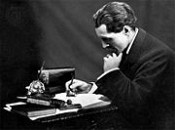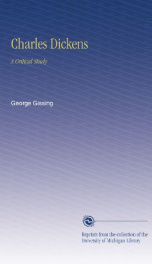Gissing George

George Robert Gissing (pronounced /ˈɡɪsɪŋ/; 22 November 1857 – 28 December 1903) was an English novelist who wrote twenty-three novels between 1880 and 1903. From his early naturalistic works, he developed into one of the most accomplished realists of the late-Victorian era. Note that the g in his last name is hard. Born in Wakefield, Yorkshire, to lower-middle class parents, Gissing went on to win a scholarship to Owens College, the present day University of Manchester. A brilliant student, he excelled at university, winning many coveted prizes, including the Shakespeare prize in 1875. When it looked as if he would go on to gain even more distinguished honours as a student and as an academic, he fell in love with a prostitute, Marianne Helen Harrison. As he lacked the means to support her himself, Gissing began to steal from his fellow students. At length, he was caught, convicted of theft, and forced to leave the university; he was sentenced to one month's hard labour in prison. In October 1876, thanks largely to a few local sympathisers, he was shipped off to the United States, where, when close to starvation, he managed to earn a precarious living by writing short stories for the Chicago Tribune. Gissing is the brother of another noted late-Victorian novelist, Algernon Gissing.[1] On returning to England in the autumn of 1877, Gissing married Marianne, and settled down in London to write novels. In 1880 when his first novel, Workers in the Dawn, proved to be an abject failure, he became a private tutor to keep poverty from the door. In 1883, he separated from his wife, now an alcoholic, but gave her a weekly income on what little money he had until her death in 1888. In 1884 his second novel, The Unclassed, which saw a marked improvement in style and characterisation, met with moderate critical acclaim. After this Gissing published novels almost on a yearly basis, but so little money did they bring him, that for several more years he had to continue working as a tutor. Although notoriously exploited by his publishers, he was able to visit Italy in 1889 from the sale of the copyright of The Nether World, his most pessimistic book. Between 1891 and 1897 (his so-called middle period) Gissing produced his best works, which include New Grub Street, Born in Exile, The Odd Women, In the Year of Jubilee, and The Whirlpool. In advance of their time, they variously deal with the growing commercialism of the literary market, religious charlatanism, the situation of emancipated women in a male-dominated society, the poverty of the working classes, and marriage in a decadent world. During this period, having belatedly become aware of the financial rewards of writing short stories for the press, he produced almost seventy stories. As a result he was able to give up teaching. In February 1891 he had married another working-class woman named Edith Underwood and moved to Exeter. Despite the marital difficulties (Edith was prone to fits of violence and mental instability) they had two children together (Walter Leonard and Alfred Charles Gissing). After several more moves, Gissing separated from Edith in 1897, leaving his two sons with his sisters in Wakefield; in 1902, Edith was certified insane. The middle years of the decade saw Gissing's reputation reach new heights: by some critics he is counted alongside George Meredith and Thomas Hardy as one of the best three novelists of his day. He also enjoyed new friendships with fellow writers such as Henry James, and H.G. Wells, and came into contact with many other up and coming writers such as Joseph Conrad and Stephen Crane. He made a second trip to Italy in 1897-1898, and also visited Greece. Towards the end of the nineties his health declined - he was eventually diagnosed with emphysema - so that he had to stay at a sanatorium from time to time. In 1898 he met Gabrielle Fleury, a Frenchwoman who had approached him in order to translate one of his novels, and fell in love with her. The following year they took part in a private marriage ceremony in Rouen, even though Gissing had been unable to obtain a divorce from Edith, and from then on they lived in France as a couple. In 1903 Gissing published The Private Papers of Henry Ryecroft, which brought him much acclaim. This is his most autobiographical work. It is the memoir of the last happy years of a writer who had struggled much like Gissing, but thanks to a late legacy had been able to give up writing to retire to the countryside. Gissing died on 28 December 1903 aged forty-six from the effects of emphysema, after having caught a chill on an ill-advised winter walk. At his death he left one unfinished novel, Veranilda, which is set in Rome during the sixth century. Gissing is buried in the English cemetery at Saint-Jean-de-Luz. George Gissing is a 'character' in Peter Ackroyd's Dan Leno and the Limehouse Golem.
do you like this author?
What readers are saying
What do you think? Write your own comment on this book!
write a commentWhat readers are saying
What do you think? Write your own comment on this author!
write a commentBook list

By the Ionian Sea
Notes of a Ramble in Southern Italy
Series:
Unknown
Year:
Unknown
Raiting:
3/5
Show more
add to favoritesadd In favorites

sleeping fires
Series:
Unknown
Year:
Unknown
Raiting:
2/5
"Sleeping Fires" is a short novella written by the English novelist George Gissing that explores the possibility of finding a former love and overcoming sorrow and guilt in middle and late life. The two major characters of the book are Edward Langley, age 42 and Lady Agnes Revill, age 37. Unlike most books by Gissing, "Sleeping Fires" ends with a sense of hope as Langley and Revill move towards each other in hope for the "day that is still granted to us." With all its Victorian details, this story speaks loudly about love as the main aim of human life. The manner in which the two primary characters verbally expose each other's shortcomings is highly modern. The book can be read easily in a single sitting.
Show more
add to favoritesadd In favorites

human odds and ends stories and sketches
Series:
Unknown
Year:
Unknown
Raiting:
2/5
The stories in this book are divided between male and female primary characters. The stories also explore the impact of class in a socially stratified society such as Victorian England. The volume is largely pessimistic and depressive in tone. Some of the highlights of the collection include the opening story "Comrades in Arms" which tells of a failed love affair between a young writer and an older woman. Literature and love also play a role in another good story, "The Poet's Portmanteau." Gissing explores differences in class and the dissatisfaction of successful, well-to-do people with their lot in "The Justice and the Vagabond", in which a Magistrate's plans to leave his family and run off with a wastrel, former school comrade are frustrated by his sudden death. Those readers who already appreciated Gissing’s books or who are familiar with Victorian literature will enjoy exploring these weird stories.
Show more
add to favoritesadd In favorites
Book list

By the Ionian Sea
Notes of a Ramble in Southern Italy
Series:
Unknown
Year:
Unknown
Raiting:
3/5
Show more
add to favoritesadd In favorites

sleeping fires
Series:
Unknown
Year:
Unknown
Raiting:
2/5
"Sleeping Fires" is a short novella written by the English novelist George Gissing that explores the possibility of finding a former love and overcoming sorrow and guilt in middle and late life. The two major characters of the book are Edward Langley, age 42 and Lady Agnes Revill, age 37. Unlike most books by Gissing, "Sleeping Fires" ends with a sense of hope as Langley and Revill move towards each other in hope for the "day that is still granted to us." With all its Victorian details, this story speaks loudly about love as the main aim of human life. The manner in which the two primary characters verbally expose each other's shortcomings is highly modern. The book can be read easily in a single sitting.
Show more
add to favoritesadd In favorites

human odds and ends stories and sketches
Series:
Unknown
Year:
Unknown
Raiting:
2/5
The stories in this book are divided between male and female primary characters. The stories also explore the impact of class in a socially stratified society such as Victorian England. The volume is largely pessimistic and depressive in tone. Some of the highlights of the collection include the opening story "Comrades in Arms" which tells of a failed love affair between a young writer and an older woman. Literature and love also play a role in another good story, "The Poet's Portmanteau." Gissing explores differences in class and the dissatisfaction of successful, well-to-do people with their lot in "The Justice and the Vagabond", in which a Magistrate's plans to leave his family and run off with a wastrel, former school comrade are frustrated by his sudden death. Those readers who already appreciated Gissing’s books or who are familiar with Victorian literature will enjoy exploring these weird stories.
Show more
add to favoritesadd In favorites

charles dickens a critical study
Series:
Unknown
Year:
Unknown
Raiting:
4/5
This volume is produced from digital images created through the University of Michigan University Library's preservation reformatting program. The Library seeks to preserve the intellectual content of items in a manner that facilitates and promotes a variety of uses. The digital reformatting process results in an electronic version of the text that can both be accessed online and used to create new print copies. This book and thousands of others can be found in the digital collections of the University of Michigan Library. The University Library also understands and values the utility of print, and makes reprints available through its Scholarly Publishing Office.
Show more
add to favoritesadd In favorites

Will Warburton
Series:
Unknown
Year:
Unknown
Raiting:
4/5
The author of this book is an English prose writer, social realist, in whose best works a change-over of a novel from Victorian to modern has reflected. Scanned version of the original volume of the 1905, this story is a real romance, a happy love-story, which in addition touches upon well-known themes of love relationships, art, and commerce. The book is written not without humor, hope and excellence, which will surprise even the admirers of G.Gissing.
Show more
add to favoritesadd In favorites

Veranilda
Series:
Unknown
Year:
Unknown
Raiting:
4.5/5
Purchase of this book includes free trial access to www.million-books.com where you can read more than a million books for free. This is an OCR edition with typos. Excerpt from book: CHAPTER III THE DEACON LEANDER The deacon Leander was some forty years of age, stoutish, a trifle asthmatic, with a long visage expressive of much shrewdness, and bushy eyebrows, which lent themselves at will to a look of genial condescension, of pious austerity, or of stern command. His dark hair and reddish beard were carefully trimmed; so were the nails of his shapely, delicate hands. His voice, now subject to huskiness, had until a few years ago been remarkably powerful and melodious; no deacon in Rome was wont to excite more admiration by his chanting of the Gradual; but that glory had passed away, and at the present time Leander's spiritual activity was less prominent than his services as a most capable steward of the patrimony of St. Peter. He travelled much, had an extensive correspondence, and was probably rather respected than reverenced by most lay folk with whom he came in contact. But in the eyes of the lady Petronilla, Leander was an ideal churchman. No one treated her judgment with so much respect; no one confided to her curious ear so many confidential matters, ranging from the secret scandals of aristocratic Rome to high debates of ecclesiastical polity or what Petronilla regarded as such. Their closer acquaintance began with the lady's presentation of certain columns of tawny Numidian marble, from a ruined temple she had inherited, to the deacon's basilica, St. Laurentius; and many were the donations which Leander had since accepted from her on behalf of the Church. In return, he had once or twice rejoiced her with the gift of a precious relic, such ascame into the hands of few below royal rank; thus had Petronilla obtained the filings of the chain of St. Peter, which, enclosed in a golden key, hung upon her bosom. Some day, as the deacon well knew, thi...
Show more
add to favoritesadd In favorites

Thyrza
Series:
Unknown
Year:
Unknown
Raiting:
4/5
Purchase of this book includes free trial access to www.million-books.com where you can read more than a million books for free. This is an OCR edition with typos. Excerpt from book: 15' CHAPTER VIII. A CLASP OF HANDS. Gra1l approached the desk with pleasure. Egremont observed it, and met his trusty auditor with the eye- smile which made his face so agreeable. ' I am sorry to see that Mr. Ackroyd no longer sits by you,' he began. ' Has he deserted us ?' Gilbert hesitated, but spoke at length with his natural directness. ' I'm afraid so, sir.' ' He has lost his interest in the subject ?' ' It's not exactly the bent of his mind. He only came at my persuasion, to begin with. He takes more to science than literature.' ' Ah, I should have thought that. But I wish he could have still spared me the two hours a week. I felt much interest in him; it's a disappointment to lose him so unexpectedly. I'm sure he has a head for our matters as we1! as for science.' Grail was about to speak, but checked himself. An inquiring glance persuaded him to say: ' He's much taken up with politics just now. They don't leave the mind very quiet.' ' Politics ? I regret more than ever that he's gone.' Egremont moved away from the desk at which he had been standing, and seated himself on the end of a bench which came out opposite the fire-place. ' Come and sit down for a minute, will you, Mr Grail ?' he said. Gilbert silently took possession of the end of the next bench. ' Is there no persuading him back ? Do you think he would come and have a talk with me ? I do wish he would; I believe we could understand each other. You see him occasionally ?' ' Every day. We work together.' ' Would you ask him to come and have a chat with me here some evening ?' ' I shall be glad to, sir.' ' Pray persuade him to. Any evening he likes. Perhaps next Sunday after the lecture would do ? Tell him to bring his pipe and have a smoke with me here befo...
Show more
add to favoritesadd In favorites

Our Friend the Charlatan
Series:
Unknown
Year:
Unknown
Raiting:
4/5
Our Friend the Charlatan. please visit www.valdebooks.com for a full list of titles
Show more
add to favoritesadd In favorites
What readers are saying
What do you think? Write your own comment on this author!
write a commentGenre
- Books
- Literature & Fiction / Authors, A-Z / ( G )
- Literature & Fiction
- Nonfiction / Social Sciences
- Biographies & Memoirs / Arts & Literature / Authors
- Nonfiction / Education / Education Theory / History
- Literature & Fiction / Drama / British & Irish
- Computers & Internet / General
- Religion & Spirituality / Christianity / Worship & Devotion / Meditations
if you like Gissing George try:
readers also enjoyed
What readers are saying
What do you think? Write your own comment on this author!
write a commentGenre
- Books
- Literature & Fiction / Authors, A-Z / ( G )
- Literature & Fiction
- Nonfiction / Social Sciences
- Biographies & Memoirs / Arts & Literature / Authors
- Nonfiction / Education / Education Theory / History
- Literature & Fiction / Drama / British & Irish
- Computers & Internet / General
- Religion & Spirituality / Christianity / Worship & Devotion / Meditations
if you like Gissing George try:
readers also enjoyed
Do you want to read a book that interests you? It’s EASY!
Create an account and send a request for reading to other users on the Webpage of the book!

